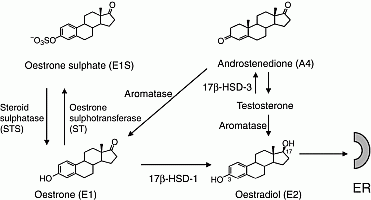SFEBES2012 Symposia Inhibiting steroid enzymes to treat common diseases (4 abstracts)
Dual aromatase and steroid sulphatase inhibition in breast cancer
Paul Foster 1 , Barry Potter 3 & Atul Purohit 2
1Centre for Endocrinology, Diabetes, and Metabolism, University of Birmingham, Birmingham, United Kingdom; 2Medicine, Imperial College London, London, United Kingdom; 3Pharmacy and Pharmacology, University of Bath, Bath, United Kingdom.
The production of oestradiol (E2) is paramount for the growth of oestrogen receptor α positive breast cancer. Various strategies have been used, including the use of enzyme inhibitors against either aromatase (AROM) or steroid sulphatase (STS), in an attempt to ablate E2 levels. Both these enzymes play a critical role in the formation of oestrogenic steroids (see figure 1) and their inhibitors are now showing success in the clinic. The studies presented here demonstrate that the inhibition of both AROM and STS enzymes using STX681, a dual AROM and STS inhibitor (DASI), is a potential new therapeutic strategy against hormone-dependent breast cancer (HDBC). MCF-7 cells stably expressing either AROM cDNA (MCF-7AROM) or STS cDNA (MCF-7STS) were generated. Ovariectomised MF-1 female nude mice receiving s.c. injections of either androstenedione (A4) or E2 sulphate and bearing either MCF-7AROM or MCF-7STS tumours were orally treated with STX64, letrozole, or STX681. Treatment was administered for 28 days. Mice were weighed and tumour measurements were taken weekly. STX64, a potent STS inhibitor, completely blocked MCF-7STS tumour growth but failed to attenuate MCF-7AROM tumour growth. In contrast, letrozole inhibited MCF-7AROM tumours but had no effect on MCF-7STS tumours. STX681 completely inhibited the growth of both tumours. AROM and STS activity was also completely inhibited by STX681, which was accompanied by a significant reduction in plasma E2 levels. These studies indicate that targeting both the AROM and the STS enzymes with a DASI inhibits HDBC growth and is therefore a potentially novel treatment for this malignancy. Consequently, clinical trials are currently underway to investigate whether this new therapeutic strategy will benefit patients with HDBC.
Declaration of interest: Conflict of interest: This research was funded by Ipsen Ltd.
Funding: No specific grant from any funding agency in the public, commercial or not-for-profit sector.

Figure 1 Origin of oestrogenic steroids in breast tissue. ER-Oestrogen Receptor.




